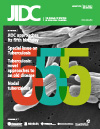Resistance patterns of Mycobacterium tuberculosis isolates from pulmonary tuberculosis patients in Nairobi
DOI:
https://doi.org/10.3855/jidc.2281Keywords:
tuberculosis, resistance patterns, susceptibility tests, multidrug resistanceAbstract
Introduction: In Kenya, which ranks thirteenth of 27 high tuberculosis burden countries, diagnosis is based on Ziehl-Neelsen staining alone and patients are treated without information on sensitivity patterns. This study aimed to determine resistance patterns of Mycobacterium tuberculosis isolated from pulmonary samples.Methodology: Pulmonary tuberculosis patients in Nairobi were randomly sampled after informed consent and recruited into the study using a structured questionnaire. Specimens were cultured in liquid and solid media, and drug susceptibility tests were performed for first-line drugs including (isoniazid, rifampin, streptomycin, ethambutol and pyrazinamide).
Results: Eighty-six (30%) of 286 isolates were resistant to at least one of five antibiotics tested. Thirty-seven (30.2%) isolates were resistant to isoniazid; 15 (11.6%) to streptomycin; 13 (4.5%) to ethambutol; four (1.4%) to rifampin ; and 30 (10.4%) to pyrazinamide. Double resistance was seen as follows: four (1.4%) isolates were resistant to both isoniazid and pyrazinamide; four (1.4%) to streptomycin and isoniazid; and one (0.3%) to rifampin and streptomycin. Two isolates (0.7%) were multidrug resistant, and one was triple resistant with an additional resistance to ethambutol. Results also showed 88.7% of patients were below the age of 40 years, while 26.3% were HIV positive. The majority of the patients (66.5%) were unemployed or self-employed in small businesses, with 79.4% earning less than 100 USD per month.
Conclusion: The high resistance observed in isoniazid, which is a first-line drug, could result in an increase in multidrug resistance unless control programs are strengthened. Poverty should be addressed to reduce infection rates.
Downloads
Published
2011-12-13
How to Cite
1.
Ndung’u PW, Kariuki S, Ng’ang’a Z, Revathi G (2011) Resistance patterns of Mycobacterium tuberculosis isolates from pulmonary tuberculosis patients in Nairobi. J Infect Dev Ctries 6:33–39. doi: 10.3855/jidc.2281
Issue
Section
Original Articles
License
Authors who publish with this journal agree to the following terms:
- Authors retain copyright and grant the journal right of first publication with the work simultaneously licensed under a Creative Commons Attribution License that allows others to share the work with an acknowledgement of the work's authorship and initial publication in this journal.
- Authors are able to enter into separate, additional contractual arrangements for the non-exclusive distribution of the journal's published version of the work (e.g., post it to an institutional repository or publish it in a book), with an acknowledgement of its initial publication in this journal.
- Authors are permitted and encouraged to post their work online (e.g., in institutional repositories or on their website) prior to and during the submission process, as it can lead to productive exchanges, as well as earlier and greater citation of published work (See The Effect of Open Access).








